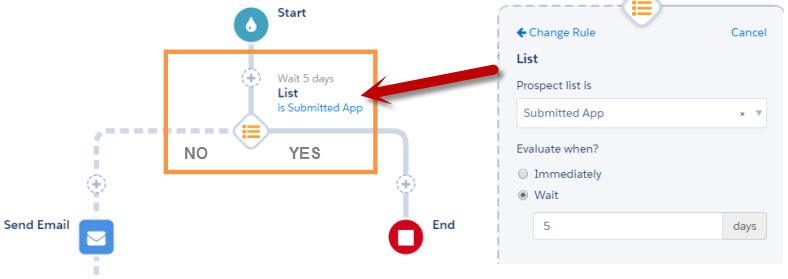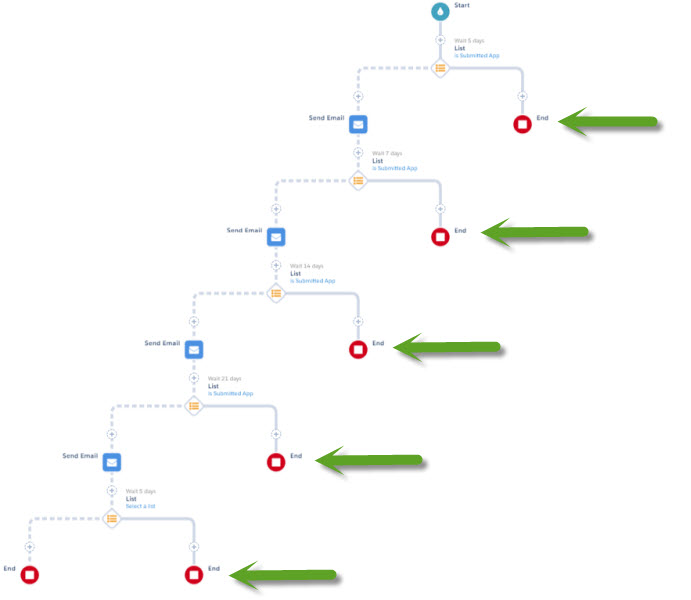Increase Application Submissions with an Automated “Enrollment Advisor” Sequence
Increase Application Submissions with an Automated “Enrollment Advisor” Sequence
When we begin a marketing engagement with a new school, one of the first things we ask is how prospective students are accessing the application. Most often, our clients fit into one of the following categories:
- The application is available for download on the website for anyone to access.
- The application is available for download on the website but it’s behind a form so they know who is downloading it.
- The application is online and often they can track those who have submitted or abandoned the application.
For those who are in the #1 bucket, the first thing we recommend is moving to #2 by putting the application behind a form. The form doesn’t need to have too many fields on it: name, email, program of interest, and anticipated start date. Putting your application behind a form allows you to do several things:
- Track the number of applications being downloaded which can be used to see if there are patterns by week, month, time of year, etc.
- Know who is downloading the application; these are perfect candidates for an email sequence.
- Gain insight into timing from application download to submission.
Now That You Know “Who” Is Downloading Your Application…
One of the most effective (and enlightening) email sequences we develop for our clients is an Application Download Sequence. After submitting a form to download the application, prospective students are automatically entered into a series of automated “personal” emails from an enrollment advisor with tips on how to apply and encouragement to connect regarding any questions they may have.
Here Is What You Need to Create This Automated Sequence
- A marketing automation system that allows you to send automated sequences.
- We use Pardot to build our Engagement Sequences.
- An email list for the contacts who are downloading your application form.
We use a completion action on our application download forms to add contacts to our nurturing sequence list. - A method of removing people from the sequence once their application has been submitted.
We use our connection to our CRM to remove people who have submitted an application; however, if you don’t have that kind of integration, you can do it by adding people to a suppression list in your marketing automation system, either manually or dynamically using relevant field values.
Preparing Your Emails
The goal of this campaign is to offer personal touch points from an enrollment advisor, but in an automated way. If your enrollment team already has a set of emails that they use for follow-up with prospective students, it is a good idea to automate this to allow them to spend their time more productively in other ways. If they don’t already have a set of emails to use, now is a great time to develop them.
Using a plain html template will make the email appear more personal and will allow you to track open and click behavior. The tone should be friendly and include tips that will help prospective students submit their application, as well as key contact information. Make sure that your reply-to email address is an inbox that is constantly monitored, as contacts will often reply to the message with questions.
Setting Up the Email Sequence – The Basics
Once you have determined the number and cadence of emails, and written the copy, it’s time to set up the email sequence in your system. At a minimum, you can use a very simple set of steps, such as the following. In this example, you would want to create a dynamic suppression list to remove anyone who submits an application from this email sequence. Also, consider adding in a call task step for your enrollment team as an additional touch point.

Setting Up the Email Sequence – Gain Insight into Your Contacts
After you’ve decided how you would like to set up your nurturing campaign, consider redesigning the sequence so you gain additional insight into your prospective students. In the example above, we used a dynamic suppression list to remove people from the sequence. Now consider using that same dynamic list of contacts who submit an application but place it as a check point before each sequence email is sent out. Here is an example:

In the above image, the rule is checking to see if the contact is a member of the list “Submitted App” before the email goes out. If the contact is on the list then they will move to the End step. If the contact is not on the list then they immediately receive the next email.
So, What Does This Accomplish?
The contact’s experience is the same and they will still receive the emails at the desired cadence. However, by setting up your sequence this way, you now have a very visual way of seeing how many people are being removed from the sequence before and after each email.
This gives you information on the timeline from application download to submission. You may also want to examine which emails are occurring before the majority of people are submitting their application, to see if there is something especially effective in the content. If one of your steps is a call task, is there any difference in the number of people dropping off at the list membership checkpoint?

It’s important to note that you want to include the list check step at the beginning of the sequence to show how many people have submitted in the period between downloading the application and the first scheduled email. These people will never receive an email but it will give you data on that metric. You also want to include a step to check application submissions a certain number of days after your last sequence email (or call task) to close the loop on that metric as well.
When building out any of your automated sequences, take a moment to try to think of ways to set up your programs so that you can gain additional insight into your prospective students’ behaviors.
How I lived, saw or experienced one of MindMax’s values this month
Get Results – Learn Always – Align to Mission – Build Meaningful Relationships – Ask for Help.
Learn Always – Often working with new clients will help challenge me to think beyond the standard processes we have put in place. Whenever I come up with a creative solution for one client, I like to think of ways I can leverage it for other clients as well. This helps me to continue to push myself to think of more efficient and effective ways to use marketing automation and CRM.
Related Ideas
Will OPMs Adapt to Meet Evolving Demands in Higher Education?

